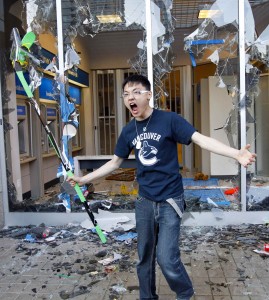
the joy of authenticity
As post-hockey riot Vancouver sweeps the last shards of glass from its sidewalks and processes a myriad insurance claims, the hand-wringing and finger pointing are proceeding apace in the mad rush to save the reputation of the so-called ‘most livable city on earth.’
But my question is – why were we so surprised?
To make sense of the images of water-polo playing sons of surgeons setting fire to police cars and private school toffs rampaging through the ruins of bank lobbies, we might learn more from the words of a dead science fiction writer than from any of the outraged utterances of the mayor and the chief of police.
J.G. Ballard would have loved this riot. In fact he consistently imagined situations like this (and worse) in his dystopian novels and short fiction. In his novella Running Wild, the children in a gated community of middle class professionals band together and slaughter their parents within the tasteful grounds and interiors of their designer homes. In High Rise, the residents of a luxury apartment tower wage tribal warfare against rival floors in an effort to alleviate the boredom of their cosseted and privileged lives.
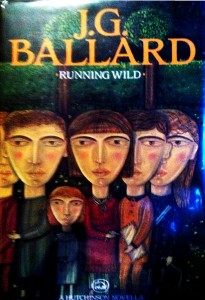
My copy of 'Running Wild'
“Unable to express their own emotions or respond to those of people around them, suffocated under a mantle of praise and encouragement, they were trapped forever in a perfect universe. In such a society, madness is the only freedom.”
J.G. Ballard: Running Wild (1988.)
In many ways Vancouver’s hockey riot was likewise an expression of raging bourgeoise ferality; essentially, a riot about nothing – a ‘Seinfeld’ of riots to which it is a mistake to ascribe any political motive. In the wake of the play-off defeat, with the Canucks scoring ‘zero,’ something had to take the place of that nothing even if that something was pointless violence. At least that could be remembered, tweeted and socially networked. To read any more into this is to be mistaken, yet for me, the underlying message is clear:
Beware of the middle class.
Especially its young men. For they exist increasingly in a state that could be described as a deficit of the real, which is dangerous and unstable place, full of unfocused outrage and an overdeveloped sense of personal entitlement that constantly simmers just below the surface. The riot wasn’t a conspiracy of any kind but rather the lack of one – a set of preconditions where a massive charge of nothingness had accumulated to which the riot was an almost electrical response; the closing of a circuit to the unmet expectations of an ontologically bereft, predominantly suburban, mob. With the loss of the game, the value of the Canuck brand (temporarily) evaporated for them, triggering a wave of buyer’s remorse through the hyped-up expectations of the crowd. In the brutal logic of the situation, the outpouring of rage had to be taken out on the city itself, the brand’s associative container. In that sense the ubiquitous slogan: ‘We are all Canucks,’ proved truer than it needed to be. The ensuing riot and looting were pure reification, a desperate desire to wrest meaning from the void, to be part of an authentically ‘real’ experience outside the purview of the corporate machine that had so spectacularly failed to deliver. No matter how one feels about it, the hockey riot unarguably ‘happened,’ the physicality of its burned-out automobiles and pillaged storefronts comprising an iconic collective experience that will be remembered for a long time to come, despite the almost immediate attempts by civic boosters to re-narrative-ize it by drawing media attention to isolated acts of heroism and the bonhomie of those engaged in the clean up effort.
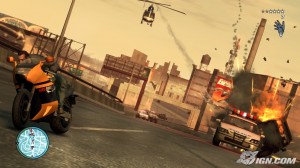
Grand Theft Auto
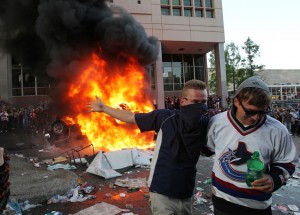
sports fan ferality
The Stars of the Riot:
White Riot – I wanna riot
White Riot – A riot of my own
The Clash – White Riot 1977
But getting back to the situation of those young, suburban men…
What would prompt a privileged Maple Ridge kid like 17 year-old Olympic hopeful, Nathan Koytlak to be photographed in front of a cheering crowd, holding a lighter and stuffing a rag into the gas tank of a police cruiser?
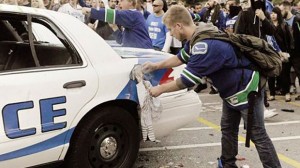
he's 'caught up in the moment'
Not to pick on young Nathan, who like so many others has issued his legally-vetted and suitably contrite public apology. In keeping with his class privilege, Nathan’s ‘brand of one’ might someday be rebuilt, but such scenes were played out countless other times, the perpetrators more or less interchangeable, all of them egged-on by appreciative, live-blogging audiences recording each detail on a panopticon of socially networked devices. In a sense the individual stars of the riot, served as avatars for the feral aspirations of the many, a kind of crowd-sourced, ‘Vancouver’s Got Talent,’ reality TV show, where in order to distinguish themselves, participants vied against each other in contests of escalating ‘bad-assedness.’
There are parallels also with computer gaming, though it would be too simplistic to call it a cause. One wonders if the ubiquitous Grand Theft Auto trope of flames and pixelated blood spatter against the backdrop of a burned out city has so thoroughly colonized the optical subconscious that it now seems natural somehow, even reassuring, a kind of default habitat where young men in particular are used to operating. The post play-off anomie created the perfect psychological environment for the unleashing this pent-up, first-person-shooter energy against the bland, manufactured seamlessness of the theme-parked urban landscape, every broken window and burned-out car as unique as a snowflake and a marker of the perpetrator’s now extended personal space.
Lek Behavior:
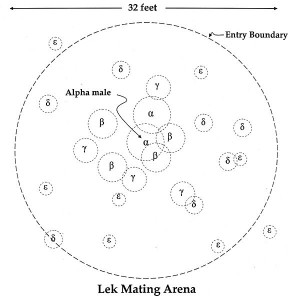
And what of the grand old game itself? Much ink has been spilled about the gratuitous violence in professional hockey. But it isn’t hockey per se. As in other sports, there is an obvious mimetic component that compels some spectators to re-enact the gladiatorial dynamic of the game outside the confines of the arena. This isn’t exactly new. Sports riots have been recorded from as far back as Roman times and have more to do with tribal rivalry than anything intrinsic to specific games. Soccer isn’t a particularly violent sport but English football hooligans are some of the most brutal fans on earth. That team sports serve as a kind of proxy combat onto which spectators project their own polemical aspirations is well known, and the environment around high stakes matches can provide ideal conditions for territorial violence by concentrating large numbers of adrenally stimulated and often intoxicated young males into confined spaces. The resultant eruptive behavior closely resembles a form of animal territorial display called ‘lekking,’ prevalent in such species as sage grouse and certain ungulates. It works (to paraphrase Wikipedia) like this:
In a lek, males of the same species meet at a preordained place (actually called an ‘arena’) and take up individual positions, each occupying and defending a small territory or ‘bubble’ where they intermittently or continuously spar with their neighbors or put on extravagant visual or aural displays. The higher the male’s status, the larger the size of the bubble he can occupy and the better and more central its location. Physical contests in these situations are frequent and females choose their mates in accordance with their dominance.
By funneling crowds containing a large proportion of young men into the so called ‘fan zone,’ the city of Vancouver unwittingly created the perfect conditions for an enormous, testosterone-charged lek. From the standpoint of biology, the mayhem that ensued was pretty much inevitable.

sage grouse lekking behavior
The only surprise to this whole sorry debacle was that police and civic officials were so woefully under-prepared. Though a similar situation had occurred back in 1994, the city was once again caught on the back foot. One can only speculate as to why. Against its spectacular backdrop of snow capped mountains and unspoiled forest verdure, the haze of magical thinking frequently occludes acknowledgement of some of Vancouver’s most pressing problems. This isn’t anyone’s fault in particular, but a kind of climatic reality – an endemic social viscosity and an overarching cultural attachment to the pursuit of personal bliss. The result, unfortunately is that some pretty big issues get swept up under the rug. The riot of 2011 affords this odd, little adolescent city an opportunity to take stock and finally begin to grow up. Let’s hope that happens soon.
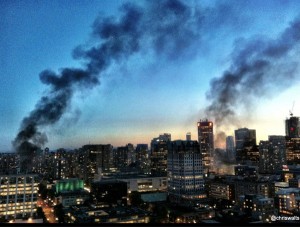
the future is feral










